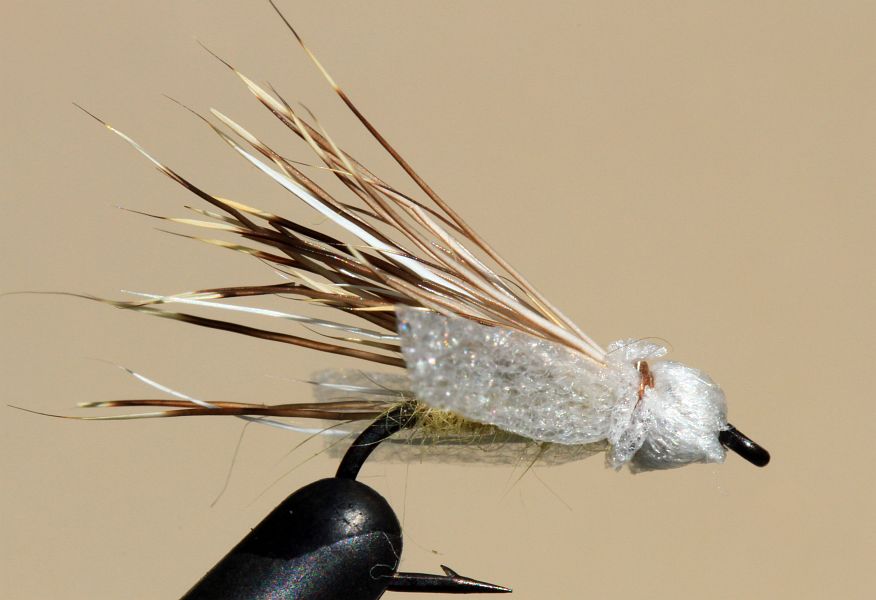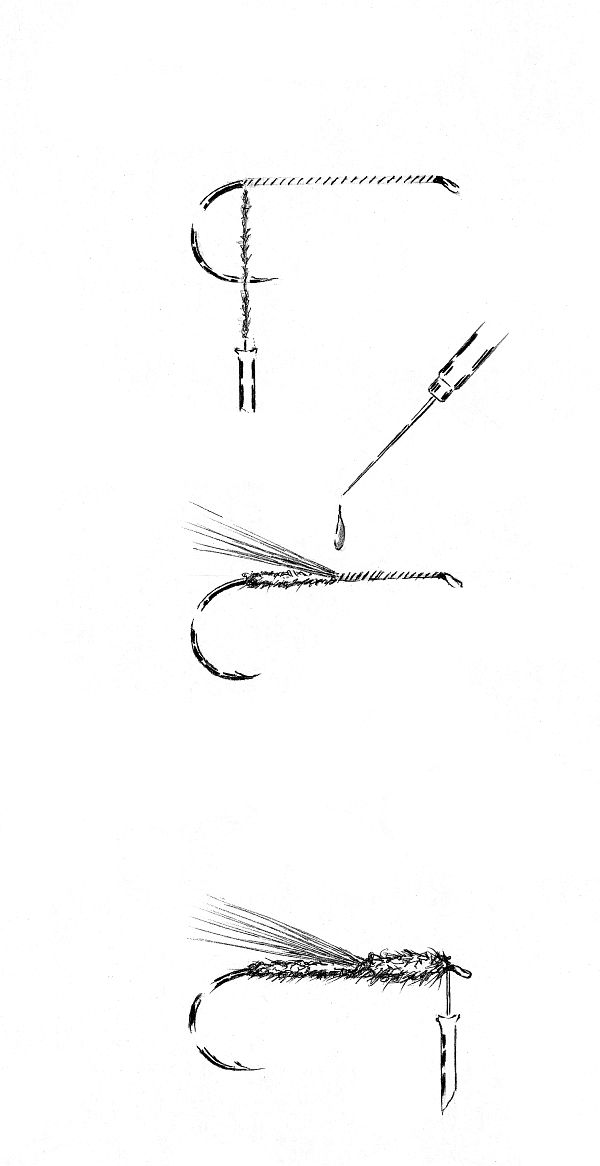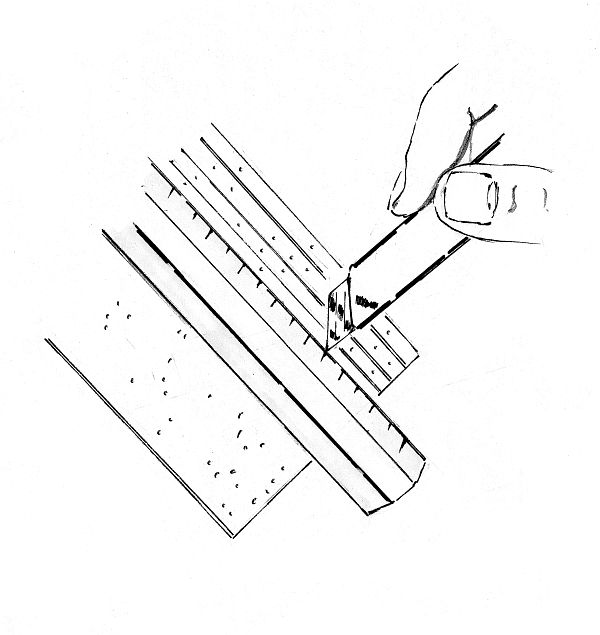THE AIR HEAD
Here is an interesting note I just got from Zamps Zamparini. He fishes the Haenertsburg waters in the Limpopo Province, but has recently been successful in Patagonia with the Air Head pattern.

The Air Head as tied by Zamps Zamparini
A couple of years ago Ed Herbst lent me a very interesting DVD by Gary La Fontaine called ‘Tying and Fishing Attractors’. Gary unfortunately died a number of years ago, but remains, in my mind, one of the most innovative fly tiers and observers of fish behaviour of our generation and I can recommend his books and DVD’s to anyone who wishes to extend his knowledge of fly fishing beyond the basics.
One fly in particular I found very interesting -The Air Head , a simple fly made up of only 3 materials- deer hair for the wing, dubbing and closed cell foam. The tying simplicity suits my fishing philosophy - I hate fussing and complicating what is essentially a sport meant to relax you, and it looked as if it could have fish ‘catchability’ particularly in fast flowing rivers.
I tied a few for the first time prior to a trip to Patagonia and I was astonished at how effective they where, so effective that the Argentinean guides raided my fly box, thankfully only at the end of my trip, and took all the remaining Air Heads. Especially impressive was how a 5 kg plus trout surfed across the surface of the fast flowing river prior to audibly smashing my tippet and fly.
I only retied and used a few Air Heads again during this Easter weekend. The results where amazing.
Using my one weight cane rod made by Steven Dugmore and a silk line by Terenzio Zandri, I fished the Broedertroom in Haenerstburg. I was relatively unsuccessful using nymphs and the normal array of dry flies in the fast water until I changed to the Air Head. The fly raised fish all around me, small wild fish, the biggest being 9 inches, some within only one to two meters from me. The next day on the Helpmekaar, where it enters Stanford Lake, once again in fast moving water, I managed to take a 1.5 kg hen fish with the same size 12 Air Head.
I believe that this simple fly, imitates a number of insects including terrestrials and perhaps tied in bigger sizes and in other colours could be used for catching bass and yellowfish.
Zamps Zamparini
Easter, 2011-04-27.

TYING THE CREAM AIR HEAD
From The Elements of Fly Tying
What you will need to tie this fly
A size 12, standard dry fly hook, pale yellow or cream-coloured tying thread, light tan or cream-coloured synthetic dubbing, deer or klipspringer hair and fine white foam (the sort you find in supermarkets for fruit packaging, but even better, the foam that digital appliances such as radios and cameras come packed in).
Tying steps
Dress the entire hook shank and don’t add any tail. Bring the thread back until the bobbin hangs just in line with the barb of the hook. Wax up a few centimetres of thread and add dubbing to form the abdomen of the fly. Dub only up to the middle of the hook shank. Now for safety, tie a half hitch knot at this point.

Cut yourself a small, 4 mm wide sheaf of deer or klipspringer hair and tie the bunch on top of the shank with the tips pointing backwards. This imitates the wing. Make sure the deer hair is secure with a few extra wraps of thread, add a drop of head cement at this point and trim off any excess butt fibres.
Wax your thread again. Add more of the same dubbing you used for the abdomen and dub the remainder of the hook shank in front of the hair wing making sure you cover the root of the wing. Dub forward to within 3mm of the eye of the hook. This dubbing constitutes the thorax of the fly so make it more prominent (wider) than the abdomen.

Now cut six thin strips of foam, each about 3 cms long and around 3 mm wide. A tip here is to lay the foam sheet on a cardboard surface, place a ruler the required distance from the edge of the foam and cut you strips with a razorblade or scalpel, following the edge of the ruler.
Tie the strips in by their butts just behind the eye of the hook so that the strips are left protruding well beyond the eye of the hook. As you tie in each segment of foam, try to place it in a slightly different position on the hook shank so that in the end your foam strips cover the top, the sides and the bottom of the shank.

Now take your tying thread back to a point about 2 mm forward of the wing root. Let the bobbin hang free and pull the strips of foam back (one at a time if you like, or all together if your dexterity allows for it) and securely fasten them to the shank while the strips are under some tension. What you have done is formed a bullet head out of the foam strips. Tie off using a wide half hitch and add a drop of head cement to the knot. Take the fly out of the vice and trim all the protruding foam strips from the underside of the fly. Leave all the other strips protruding, but trim them to around 1.5 cm long.

An Cream Air Head tied by Tom Sutcliffe using Klipspringer hair for the wings
Gary La Fontaine tied olive and brown versions to imitate different stonefly species and I suggest you do the same.
How to fish this pattern
Clearly you aren’t going to dress this fly with silicone because of all the foam on it. I suggest tying a few really small patterns, say on size 16 hooks and a couple of bigger patterns on size 10 hooks. Fish them in riffles or rough water that would swamp standard dry flies and add a twitch or two in the drift from time to time.
Then for lakes tie a few patterns using yellow dubbing and red deer hair or bucktail for the wings, imitating, as you no doubt already guessed, a grasshopper. Fish them in the deep water along the wall, again with the odd little twitch thrown in.

Yellowfish
Gary Glen-Young ties an interesting variation of the Air Head to imitate adult caddis flies and terrestrials for yellowfish. See it on page 57 of FOSAF’s book Favoured Flies Volume 1.
Gary La Fontaine has got onto something really useful with this pattern. I hope it works for you.
Here are some links for further reading:
http://www.louisvilletu.org/fly_tying/air_head.pdf
http://nwflytyer.files.wordpress.com/2009/04/air-head2.jpg
http://www.swedneckflyfishing.com/airhead.htm
For further viewing contact Craig Thom of www.netbooks.co.za who has DVDs in stock of Gary La Fontaine tying his classic patterns including the Air Head.
***


